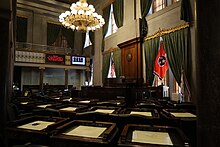
Back مجلس شيوخ تينيسي Arabic Senat von Tennessee German Senato del Tennessee Italian テネシー州議会元老院 Japanese Tennessee Senate SIMPLE Tennessee Chham-gī-īⁿ ZH-MIN-NAN
Senate of Tennessee | |
|---|---|
| Tennessee General Assembly | |
 | |
| Type | |
| Type | |
Term limits | None |
| History | |
New session started | January 14, 2025 |
| Leadership | |
Speaker pro tempore | |
Majority Leader | |
Minority Leader | |
| Structure | |
| Seats | 33 |
 | |
Political groups | Majority party
Minority party
|
Length of term | 4 years |
| Authority | Article III, Tennessee Constitution |
| Salary | $24,316/year + per diem, employee benefits, travel reimbursement[1] |
| Elections | |
Last election | November 8, 2022 (17 seats) |
Next election | November 5, 2024 (16 seats) |
| Redistricting | Legislative Control |
| Meeting place | |
 | |
| State Senate Chamber Tennessee State Capitol Nashville, Tennessee | |
| Website | |
| Tennessee Senate | |
| Rules | |
| Permanent Rules of Order for the 113th General Assembly | |
The Tennessee Senate is the upper house of the U.S. state of Tennessee's state legislature, which is known formally as the Tennessee General Assembly.
The Tennessee Senate has the power to pass resolutions concerning essentially any issue regarding the state, country, or world. The Senate also has the power to create and enforce its own rules and qualifications for its members. The Senate shares these powers with the Tennessee House of Representatives. The Senate alone has the power to host impeachment proceeding and remove impeached members of office with a 2/3 majority. The Tennessee Senate, according to the state constitution of 1870, is composed of 33 members, one-third the size of the Tennessee House of Representatives. Senators are to be elected from districts of substantially equal population. According to the Tennessee constitution, a county is not to be joined to a portion of another county for purposes of creating a district; this provision has been overridden by the rulings of the Supreme Court of the United States in Baker v. Carr (369 U.S. 182, 1962) and Reynolds v. Sims (337 U.S. 356, 1964). The Tennessee constitution has been amended to allow that if these rulings are ever changed or reversed, a referendum may be held to allow the senate districts to be drawn on a basis other than substantially equal population.
Until 1966, Tennessee state senators served two-year terms. That year the system was changed, by constitutional amendment, to allow four-year terms. In that year, senators in even-numbered districts were elected to two-year terms and those in odd-numbered districts were elected to four-year terms. This created a staggered system in which only half of the senate is up for election at any one time. Senators from even-numbered districts are elected in the same years as presidential elections, and senators from odd-numbered districts are elected in the same years as mid-term elections. Districts are to be sequentially and consecutively numbered; the scheme basically runs from east to west and north to south.[citation needed]
Republicans attained an elected majority in the Senate in the 104th General Assembly (2005–07) for the first time since Reconstruction; a brief majority in the 1990s was the result of two outgoing senators switching parties. Following the 2018 elections, there were no Democratic senators from East Tennessee. There were three Democrats from Memphis in West Tennessee, and three from Middle Tennessee, two from Nashville and one from the Nashville suburb of Goodlettsville.
- ^ "2022 Legislator Compensation". www.ncsl.org.